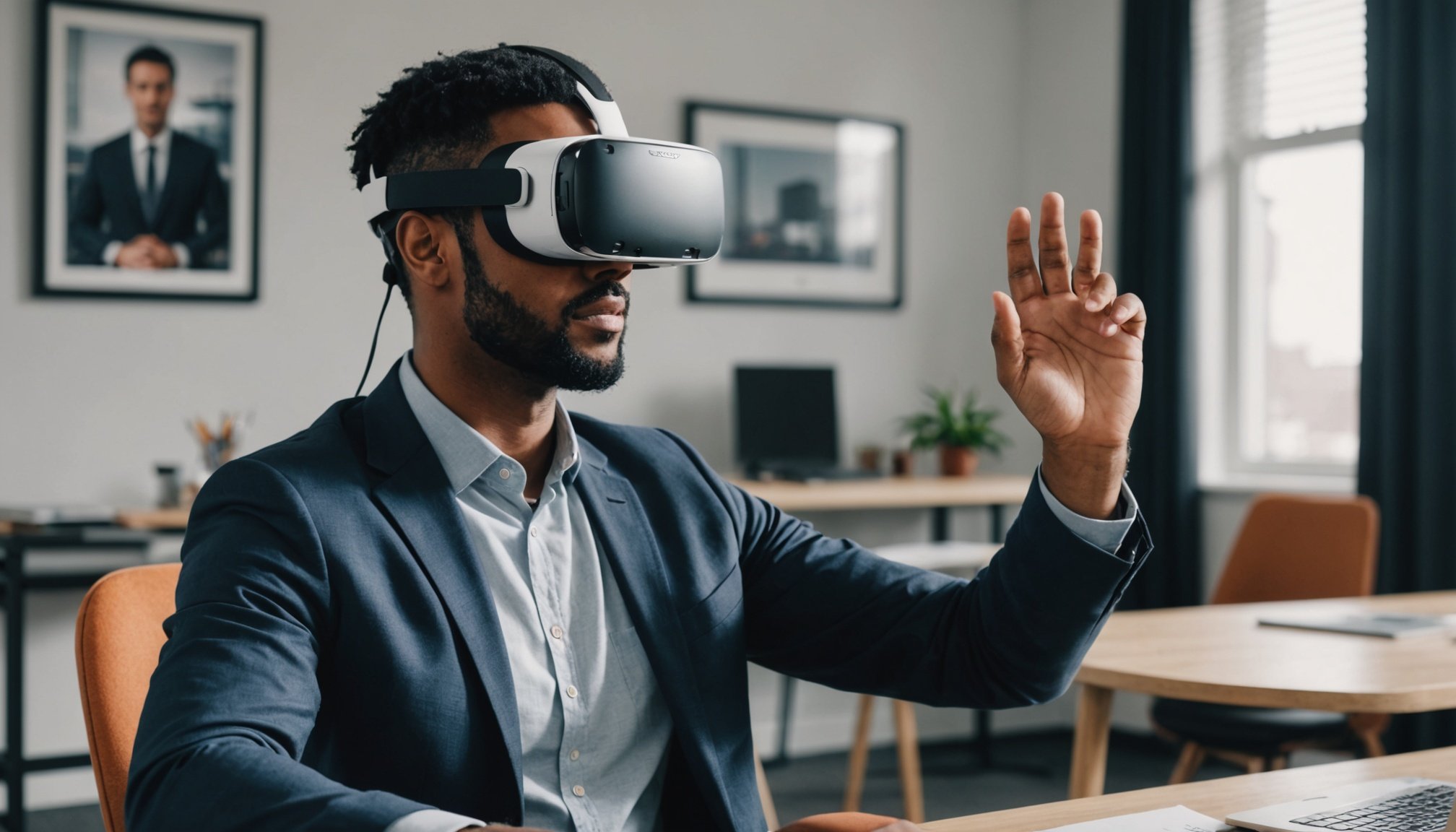The Role of Virtual Reality in Remote Collaboration
In today’s digital age, virtual reality (VR) stands as a transformative technology reshaping how we engage in remote collaboration. VR technology provides immersive experiences that go beyond traditional digital communication tools. At its core, VR offers enhanced, lifelike interactions that are crucial for effective collaboration.
When comparing traditional remote tools to VR solutions, the benefits are apparent. Traditional methods like video calls or emails often miss the nuanced elements of communication, including non-verbal cues, which are paramount in meaningful interactions. VR, on the other hand, enables users to perceive surroundings in 3D environments, thereby capturing gestures and expressions that are often lost in two-dimensional platforms.
Also to read : Unlocking digital access: ensuring inclusive user experience for everyone
Moreover, the immersive experience of VR helps bridge geographical gaps, transforming collaborations into dynamic and interactive sessions. This not only enhances communication but also leads to more productive meetings where all participants feel engaged.
By embracing this transformative technology, companies can foster closer connections among remote teams, ultimately leading to improved innovation and problem-solving capabilities. As businesses continue to navigate remote operations, VR could very well be the key to unlocking new levels of collaboration efficiency.
Have you seen this : Unlocking digital access: ensuring inclusive user experience for everyone
Benefits of Virtual Reality for Remote Teams
Virtual reality (VR) is revolutionizing remote teamwork by offering distinct advantages that enhance communication, increase engagement, and improve decision-making.
Enhanced Communication
VR tools provide platforms for real-time dialogue, allowing users to communicate efficiently. Unlike traditional methods, VR enables the exchange of non-verbal cues, such as gestures and facial expressions, vital for meaningful discussions. This immersive environment allows for a communication experience more akin to in-person interactions, addressing the limitations inherent in video calls and emails. Users can enter shared virtual spaces, fostering a sense of presence and enhancing understanding among team members.
Increased Engagement
Remote teams often struggle with engagement, but VR offers innovative strategies to remedy this. By immersing team members in interactive environments, VR maintains interest and encourages active participation. Quantitative metrics indicate that teams using VR report higher engagement rates, leading to more dynamic collaboration. With VR, team involvement is elevated as participants can interact more naturally, leading to improved focus and productivity.
Improved Decision Making
By utilising VR technology, remote teams can visualise data more effectively. Virtual reality allows for scenario-based training, enabling teams to make informed decisions collaboratively. Through case studies, it is evident that VR aids in replicating real-world situations, providing a robust platform for collective decision-making.
Industry Applications of Virtual Reality
In recent years, virtual reality has become a pivotal transformative technology, creating new opportunities across different sectors. Its ability to provide immersive experiences has led to its adoption in areas like business, education, and healthcare.
Business Sector
In the business world, VR is utilized for enhanced corporate training and interactive meetings. Global teams benefit enormously as VR fosters seamless cross-cultural collaboration, allowing participants to engage in lifelike meetings without physical presence. This immersion can lead to better understanding and efficiency.
Educational Institutions
In education, VR paves the way for interactive learning experiences. It transforms remote classrooms into engaging environments where students can explore concepts more deeply. VR’s role in capturing students’ attention translates into improved learning outcomes and active participation.
Healthcare Settings
In healthcare, VR supports telehealth innovations and patient interactions. Training simulations using VR enable medical professionals to sharpen their skills collaboratively. By replicating real-life scenarios, these simulations enhance the preparedness of health teams in patient care.
Challenges and Limitations of VR in Remote Collaboration
Virtual reality (VR), despite its transformative capacity in remote collaboration, faces several challenges. Firstly, there are technical barriers such as bandwidth and hardware requirements that could hinder seamless VR experiences. High-end VR equipment demands significant internet speeds and robust devices, which might not be accessible to all users, limiting its widespread adoption.
User resistance also poses a challenge. The learning curve associated with new technology can deter teams from embracing VR. Many users may find it daunting to navigate virtual environments, preferring familiar traditional tools instead. Engaging reluctant users requires effective training and user-friendly platforms to ease the transition.
Privacy and security concerns are critical in virtual environments. As VR platforms handle sensitive data, ensuring secure communications while maintaining privacy is paramount. Companies need to employ stringent security protocols to safeguard information, especially given the immersive nature of VR that might inadvertently capture more than intended.
Addressing these challenges is vital for VR to reach its full potential in remote collaboration. Only by overcoming these barriers can VR truly revolutionize how teams connect and work remotely.
Implementing Virtual Reality in Remote Collaboration
Adopting virtual reality (VR) for remote collaboration demands thoughtful integration. Prioritising the right tools is essential for success.
Choosing the Right VR Tools
When choosing VR tools, organisations should consider criteria such as user-friendliness, scalability, and hardware compatibility. Conducting a cost-benefit analysis helps identify solutions that align with business needs while offering efficient returns. Balancing features with budget constraints ensures a smart investment.
Training and Support
Implementing VR technology requires robust training programs to ease the transition. These programs should cover the platform and strategies to maximise its potential. Resources for continuous support are critical, giving team members access to a network of assistance and community engagement. These elements increase user confidence and adoption.
Measuring Success
To evaluate VR’s efficacy in remote collaboration, key performance indicators (KPIs) such as team productivity, engagement, and overall satisfaction should be measured. Collecting consistent feedback can refine interactions and improve user experience. Metrics provide insights into how VR integration meets its objectives, allowing for strategic adjustments as needed.
The Future of Virtual Reality in Remote Collaboration
The future of VR in remote collaboration is poised to bring revolutionary changes. Predictions suggest that virtual reality will continue to evolve, becoming an integral part of workplace environments. As organisations increasingly embrace remote work trends, VR offers unparalleled opportunities to recreate in-person experiences.
Emerging technologies such as artificial intelligence (AI) and augmented reality (AR) are set to intersect with VR, amplifying its capabilities. VR will not only enhance visualisation but also enable intuitive interactions, making it easier to process complex information. This technological advancement can lead to smoother communication and more cohesive collaboration among remote teams.
Additionally, there is a cultural shift towards embracing these transformative technologies. The younger workforce, familiar with digital innovations, will drive the acceptance of VR in professional settings. Moreover, as global connectivity becomes the norm, VR can help bridge cultural divides, facilitating effective cross-cultural collaborations.
Looking ahead, VR’s role in remote collaboration will expand, offering insights into new work models and team dynamics. Workplace strategies will need to adapt, ensuring that these advancements align with organisational goals and foster inclusive environments for innovation and success.










